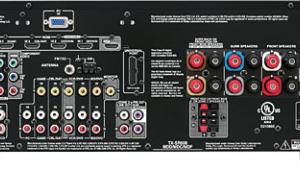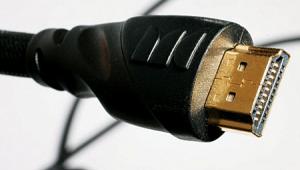AV overhaul in the future, rear projection TV is 11 years old.
Bass Management and the LFE Channel
Salt, however, even though it is a good thing, can effectively destroy the taste of fine foods when it is used improperly or in excess. The analogy holds true for bass as well. Just as it is possible to ruin food with salt, it is equally possible to ruin a sound system with bass. Most of us can recall all too well the reaction we have when the bass is wrong. It's comparable to the reaction of my dear friend to his slice of watermelon after he accidentally dumped an entire shaker of salt on it. Yuk!
Our objective is to use bass to enhance our listening experience. Herein lies one of home theater's biggest challenges, because three different forces are working against us to turn bass into, well, salted tea. First, the rooms that we wrap around our fine sound systems are not inherently friendly to bass. Second, the character of bass in the program material we listen to varies dramatically. Third, the equipment we use can make such a confounded tangle out of bass-signal routing that only someone with a Ph.D. in electrical engineering can straighten it out. Enter bass management to save the day!
The Beginnings of Bass Management
The term bass management was coined by yours truly around 1995 to describe a complex series of advanced functions for AV controllers to assist users in the arduous task of configuring their systems to optimally address the aforementioned challenges of bass reproduction. However, some of the concepts for bass management come from earlier systems.
The origins of bass management can be traced all the way back to the 1980s, when Miller & Kreisel Sound and Triad Speakers began advocating the use of satellite/subwoofer systems. At the same time, Dolby Laboratories introduced the Bass Splitting feature to route bass away from small center speakers in Pro Logic decoders.
The next level of bass management came along in 1990 with the Lucasfilm THX standards, which required each speaker to produce 105dB of bass output at the listening position to match the film-studio experience. Realizing that a speaker capable of producing such a prodigious amount of bass would be impractical in all but the rarest of rooms, THX opted for a basic form of bass management to reduce the requirements for speakers. The bass from all the main channels was redirected to one or more subwoofers, allowing the speaker system to produce plenty of bass-kickage in the room with main speakers the size of most "bookshelf" speakers.
The final development of the full concept for bass management occurred when Dolby Digital and DTS discrete 5.1-channel digital formats were released to the consumer market circa 1995. Both formats included an additional channel, called LFE (Low Frequency Effects) dedicated to high-volume bass sound effects that required a playback system capable of producing 115dB of bass at the listening position. To optimize the reproduction of low frequencies for these new formats, bass management would include:
1. A test system to determine the frequency extension and headroom of every speaker (including subwoofers) in a sound system;
2. A frequency-agile crossover filter for each speaker to ensure that it received only what it was able to reproduce;
3. An intelligent redirection and resource-pooling system to optimize the bass headroom of the entire system;
4. A bass peak-level limiter for each speaker to prevent bass from overloading it;
5. A room-correction system to optimize the bass output of a system by analyzing a room's standing-wave resonance and boundary-reflection patterns and applying correction filters where appropriate.
Unfortunately, bass management in its fully developed form never made it to the consumer market in 1995, and is still not available today. Instead, less sophisticated versions that include parts and pieces of the master plan were implemented in AV controllers, with the version required by THX for its licensees being the most common.
The Basics of Bass Management
What we find today in most AV controllers is a form of bass management that includes a highpass (low-cut) filter for each main speaker (front left & right, center, side left & right, and rear left & right if applicable), a corresponding lowpass (high-cut) filter for the subwoofer output, a redirection function for bass below the main speakers' highpass filter frequency, and a bass peak-level limiter.
Unless there are extenuating circumstances, experts agree that all main speakers should be highpass filtered in rooms where the length and width dimensions are less than 40 feet. Standing-wave resonances in such rooms make speakers impossible to place for both smooth bass response and imaging accuracy. Applying highpass filters to the speakers frees them up to be placed for imaging accuracy while not adversely affecting their bass, which is played by subwoofers that can be positioned for smoothest bass response. The highpass filters also release the main speakers from the intense responsibility of playing bass at high volumes, as mentioned above.
The main-speaker highpass filters and subwoofer-output lowpass filters should be set according to two factors: room resonances and the bass-reproduction capabilities of the main speakers (see Fig. 1). Ideally, the user would tell the controller to apply a filter to each speaker at the best frequency for that speaker. In the real world, controllers often limit users to either a global variable frequency that affects all speakers or a fixed frequency for all speakers. Controllers with a fixed frequency for all speakers offer the option of Large or Small speakers, with the Large setting removing the filter and the Small setting applying the filter. If the controller offers frequency-agile filters, then the filter frequency is selectable in addition to the Large/Small setting.
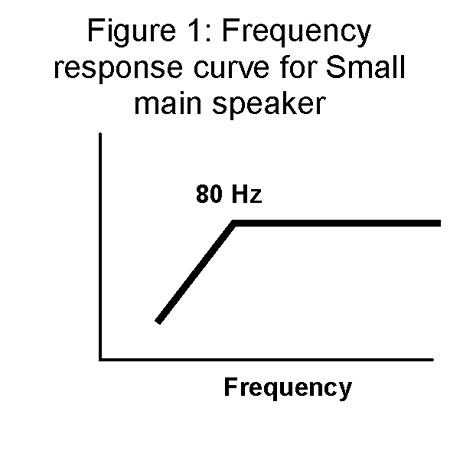
Although we would like to have frequency-agile filters, fixed-frequency filters are not all bad. An extensive survey conducted in Europe showed that 80Hz is the best all-around choice for fixed-frequency filters. In the survey, the vast majority of humans began to distinguish subwoofer directionality at a mean frequency of 185 Hz, and 80 Hz was the absolute minimum case below which no one heard directionality. This has led most manufacturers to choose 80 Hz as the frequency for their fixed filters. Primary room resonances are usually below 80 Hz, so the main speakers can be placed for imaging accuracy without concern over bass resonances (see Fig. 2). In addition, relatively small speakers are able to produce 105dB above 80 Hz under average conditions.
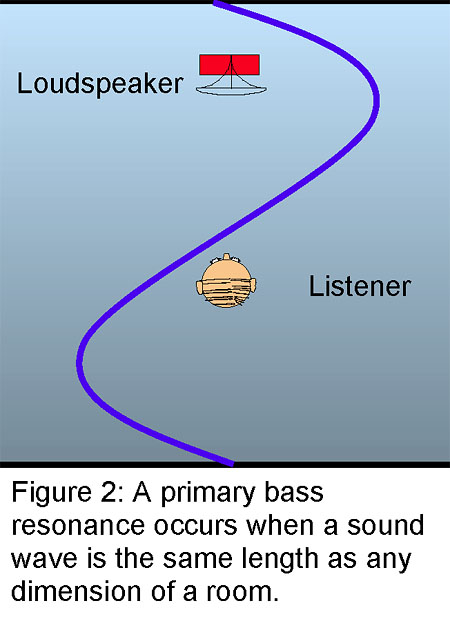
Bass redirection comes next. (Well, it actually comes before the filtering, but let's not go there...) In a perfect bass-redirection system, bass from any channel could be routed to any other channel at any level and at any frequency. For example, in a system with all small speakers and no subwoofers, the controller would redistribute bass frequencies from each main channel and the LFE channel at a reduced level to all the speakers in order to achieve the highest possible bass headroom from the small speakers.
Unfortunately, the average bass-redirection system is far from perfect. Some AV controllers have nothing more than the minimum Dolby requirements of (1) Large Front/Small Center and Surround/No Subwoofer and (2) Small Front, Center, and Surround/Subwoofer On. In the first case, bass below the center and surround speakers' highpass-filter frequency, along with the LFE channel, is fed to the Front speakers (see Fig. 3). In the second case, all the bass below the front, center, and surround speakers' highpass-filter frequency, along with the LFE channel, is fed to the subwoofer output (see Fig. 4). Most controllers, though, fall somewhere in between the full-blown redirection system and the minimum requirement.
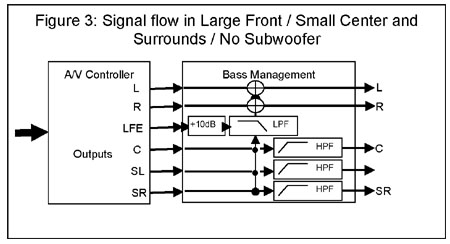
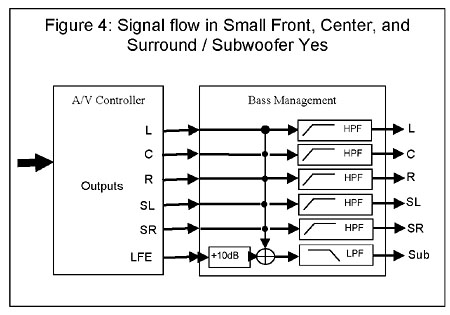
Sometimes, a controller provides the user with the option of redirecting bass from small speakers to both the subwoofer output and any large speakers. It's generally a bad idea to select this option because the large speakers will interfere with the bass from the subwoofers. The better choice is to send bass from small main speakers to the subwoofers and the subwoofers only, which is what most controllers do.
- Log in or register to post comments

this is great info,i have both of my 8inch subs set on at 80hzs and sound of bass is wonderful.

